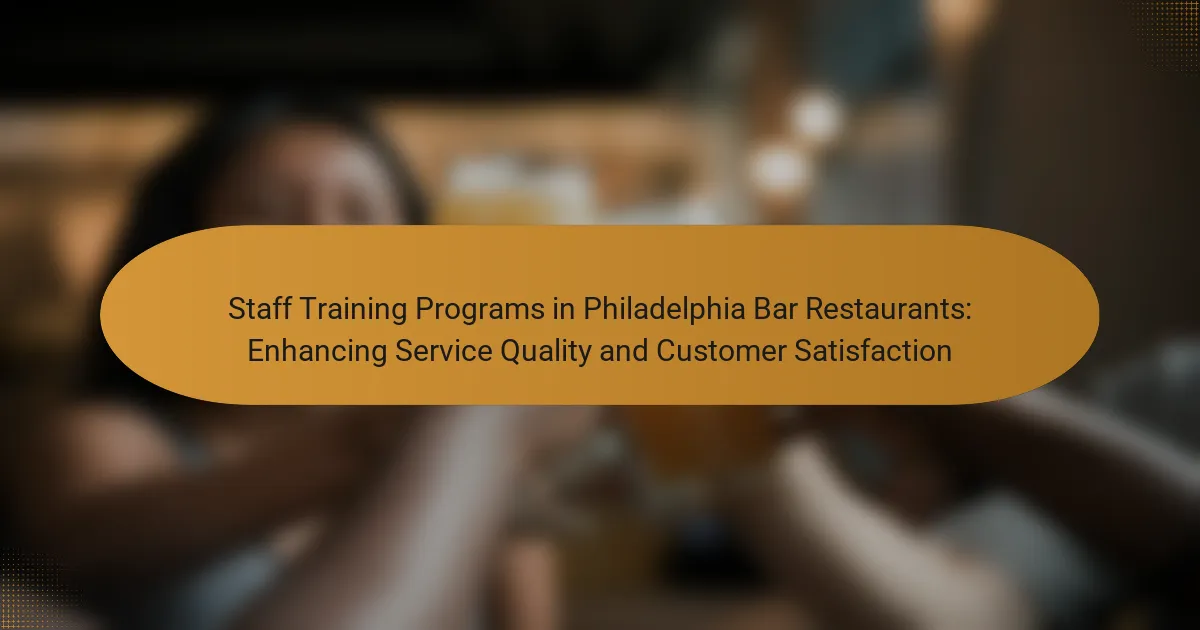
What are Staff Training Programs in Philadelphia Bar Restaurants?
Staff training programs in Philadelphia bar restaurants are structured initiatives designed to enhance employee skills and service quality. These programs typically cover topics such as customer service, food safety, and beverage knowledge. They aim to improve staff performance and ensure compliance with health regulations. Many bar restaurants in Philadelphia implement these training sessions regularly. Research shows that effective training can lead to higher customer satisfaction and repeat business. Additionally, trained staff can contribute to a positive dining atmosphere. This focus on training is crucial in a competitive market like Philadelphia’s bar and restaurant scene.
How do these programs enhance service quality?
Staff training programs enhance service quality by equipping employees with essential skills and knowledge. These programs focus on customer service techniques, product knowledge, and effective communication. Employees trained in these areas can better meet customer needs and expectations. Studies show that well-trained staff contribute to higher customer satisfaction rates. For instance, a survey by the American Hotel and Lodging Educational Institute found that 80% of customers reported improved experiences with trained staff. Additionally, training programs often include role-playing scenarios that prepare employees for real-life situations. This hands-on approach builds confidence and competence in service delivery. Overall, these programs lead to a more efficient and customer-focused service environment.
What specific skills are taught in these training programs?
Staff training programs in Philadelphia bar restaurants teach several specific skills. These skills include customer service techniques, effective communication, and conflict resolution. Additionally, training covers product knowledge, including food and beverage pairings. Bartending skills, such as cocktail preparation and drink presentation, are also emphasized. Time management and multitasking skills are crucial for efficient service. Training programs often incorporate teamwork strategies to enhance collaboration among staff. Lastly, programs may include training on health and safety standards relevant to food service. These skills collectively aim to enhance service quality and customer satisfaction in the bar restaurant environment.
How do training programs impact employee performance?
Training programs enhance employee performance by improving skills and knowledge. They provide employees with the tools necessary to perform their jobs effectively. Enhanced skills lead to increased productivity and efficiency. Employees who undergo training are often more confident in their roles. This confidence translates to better customer interactions and service quality. A study by the American Society for Training and Development found that companies with comprehensive training programs enjoy 218% higher income per employee. Additionally, organizations that invest in employee training see a 24% higher profit margin. These statistics demonstrate the direct correlation between training programs and improved employee performance.
Why is customer satisfaction important in bar restaurants?
Customer satisfaction is crucial in bar restaurants because it directly influences repeat business and customer loyalty. Satisfied customers are more likely to return and recommend the establishment to others. According to a study by the American Express, 70% of consumers say they have spent more money to do business with a company that delivers great service. High levels of customer satisfaction can also lead to positive online reviews and social media mentions, which are vital in attracting new customers. Additionally, satisfied customers tend to spend more per visit, enhancing overall revenue. In contrast, low customer satisfaction can lead to negative experiences, resulting in lost business and damaging a bar restaurant’s reputation. Thus, prioritizing customer satisfaction is essential for long-term success in the competitive bar restaurant industry.
What role does staff training play in achieving customer satisfaction?
Staff training plays a crucial role in achieving customer satisfaction. Well-trained staff can deliver high-quality service consistently. This consistency leads to positive customer experiences. Research shows that 70% of customer satisfaction is influenced by employee engagement. Engaged employees are more likely to meet customer needs effectively. Additionally, training equips staff with product knowledge and problem-solving skills. These abilities enable staff to handle inquiries and complaints efficiently. Consequently, effective staff training directly correlates with enhanced customer satisfaction levels.
How can training programs address common customer complaints?
Training programs can effectively address common customer complaints by equipping staff with necessary skills. These programs teach employees how to handle customer inquiries and resolve issues promptly. Improved communication skills lead to better customer interactions. Training also emphasizes the importance of empathy in service. Staff learn to understand customer perspectives and respond accordingly. Role-playing scenarios during training can simulate real complaints. This practical approach prepares employees for actual situations. Statistics show that businesses with comprehensive training programs see a 24% increase in customer satisfaction. Enhanced service quality directly reduces the frequency of complaints.

What types of training programs are available in Philadelphia bar restaurants?
Philadelphia bar restaurants typically offer several types of training programs. These include bartending skills training, which focuses on drink preparation and customer service. Additionally, there are programs for food safety and sanitation, ensuring compliance with health regulations. Customer service training is also common, aimed at enhancing guest interactions. Some establishments provide management training for supervisory roles. Furthermore, mixology courses are available to enhance cocktail-making expertise. These programs are essential for maintaining high service standards and customer satisfaction in the competitive Philadelphia dining scene.
How do on-the-job training and formal training differ?
On-the-job training and formal training differ primarily in their delivery methods. On-the-job training occurs in the actual work environment. It allows employees to learn through practical experience and immediate application of skills. This type of training is often informal and tailored to specific job roles.
In contrast, formal training is structured and typically takes place in a classroom or training facility. It follows a predefined curriculum and often includes lectures, workshops, or online courses. Formal training provides a comprehensive overview of concepts and theories.
On-the-job training fosters hands-on experience, while formal training emphasizes theoretical knowledge. Studies show that on-the-job training can lead to faster skill acquisition due to real-time feedback. Formal training often ensures a broader understanding of industry standards and practices.
What are the advantages of each training type?
On-the-job training allows employees to learn in a real work environment. This type of training enhances practical skills immediately applicable to their roles. It fosters teamwork and communication among staff. Peer feedback during on-the-job training can improve performance rapidly.
Classroom training provides structured learning and theoretical knowledge. It allows for interactive discussions and the sharing of diverse experiences. Classroom settings can facilitate networking among employees from different departments. This training type can cover a wide range of topics efficiently.
E-learning offers flexibility and accessibility for staff. Employees can learn at their own pace and revisit materials as needed. E-learning can incorporate multimedia elements, making it engaging. This method often reduces training costs by minimizing the need for physical materials.
Mentorship programs provide personalized guidance and support. They help new staff acclimate to workplace culture and expectations. Mentorship fosters long-term relationships that can enhance employee retention. This type of training can lead to professional growth and development.
Simulation training allows employees to practice skills in a controlled environment. This method can enhance decision-making and problem-solving abilities. Simulations provide a safe space to make mistakes without real-world consequences. They can improve confidence and readiness for actual job scenarios.
How is training effectiveness measured in these programs?
Training effectiveness in staff training programs is measured through several key metrics. Common methods include pre- and post-training assessments. These assessments evaluate knowledge and skills gained during the training. Observational evaluations during service interactions also provide insights into performance changes. Customer feedback and satisfaction surveys are critical for assessing service quality improvements. Employee retention rates can indicate the long-term effectiveness of training initiatives. Additionally, performance metrics such as sales figures and service speed are analyzed. These measurements collectively demonstrate the impact of training on both staff performance and customer satisfaction.
What role does technology play in staff training?
Technology plays a crucial role in staff training by enhancing learning efficiency and engagement. It provides diverse training methods such as e-learning, virtual simulations, and mobile applications. These methods cater to different learning styles and can be accessed anytime and anywhere. This flexibility allows staff to learn at their own pace. Research indicates that organizations using technology for training see a 42% increase in employee productivity. Additionally, technology enables real-time feedback and assessments, helping to identify areas for improvement. Overall, technology streamlines the training process and improves overall service quality in bar restaurants.
How can online training platforms enhance learning?
Online training platforms enhance learning by providing flexible access to educational resources. They allow users to learn at their own pace, accommodating different learning styles. Interactive features, such as quizzes and simulations, engage learners effectively. These platforms often include multimedia content, which caters to visual and auditory learners. Analytics tools track progress, helping instructors tailor content to individual needs. Additionally, online forums foster collaboration and discussion among learners. According to a study by the Journal of Online Learning Research, online training can improve retention rates by 25-60%. This demonstrates the effectiveness of online training platforms in enhancing learning outcomes.
What tools are commonly used in training programs?
Common tools used in training programs include Learning Management Systems (LMS), e-learning modules, and virtual classrooms. LMS platforms like Moodle and Blackboard facilitate course management and tracking. E-learning modules provide interactive content for self-paced learning. Virtual classrooms enable real-time instruction and collaboration. Additionally, video conferencing tools like Zoom enhance remote training sessions. Assessment tools measure learner progress and effectiveness. These tools collectively improve engagement and knowledge retention in training programs.

What challenges do Philadelphia bar restaurants face in implementing training programs?
Philadelphia bar restaurants face several challenges in implementing training programs. Limited financial resources often restrict their ability to invest in comprehensive training. High employee turnover rates complicate the consistency of training efforts. Scheduling conflicts can make it difficult to find suitable times for training sessions. Additionally, varying levels of employee experience may hinder the effectiveness of a standardized training program. Regulatory compliance requirements add another layer of complexity to training initiatives. Lastly, the fast-paced environment of bar restaurants can lead to resistance from staff who may prioritize immediate tasks over training commitments.
How can budget constraints affect training opportunities?
Budget constraints limit training opportunities by reducing available resources for program development. This often leads to fewer training sessions being offered. Staff may receive less comprehensive training due to financial limitations. Consequently, employees might not acquire necessary skills or knowledge. Reduced training can negatively impact service quality. A study by the American Society for Training and Development found that organizations with higher training budgets report better employee performance. Thus, budget constraints can significantly hinder the effectiveness of training programs in enhancing service quality and customer satisfaction.
What strategies can be used to overcome financial limitations?
To overcome financial limitations, businesses can implement cost-cutting measures. This includes reducing unnecessary expenses and optimizing operational efficiency. Another strategy is to explore alternative funding sources. Options like grants, loans, or crowdfunding can provide necessary capital. Additionally, increasing revenue streams can be effective. This can involve diversifying services or products offered. Investing in staff training can lead to improved service quality, ultimately attracting more customers. According to the National Restaurant Association, well-trained staff can enhance customer satisfaction, leading to increased sales.
How do staff turnover rates impact training effectiveness?
High staff turnover rates negatively impact training effectiveness. Frequent turnover leads to inconsistent training experiences. New employees may not receive adequate training before their departure. This results in a lack of mastery in essential skills. A study by the Society for Human Resource Management found that high turnover can increase training costs by 200% to 300%. Additionally, constant changes in staff disrupt team cohesion. This disruption can hinder the application of learned skills in real-world scenarios. Consequently, the overall service quality may decline, affecting customer satisfaction.
What best practices can improve staff training programs?
Effective staff training programs can be improved through several best practices. First, establish clear training objectives. These objectives should align with the restaurant’s service goals and customer satisfaction standards. Second, incorporate hands-on training methods. Practical experience enhances learning retention and builds confidence in staff. Third, utilize a variety of training materials. Videos, manuals, and interactive sessions cater to different learning styles. Fourth, encourage feedback from staff during training. This feedback can identify areas for improvement and increase engagement. Fifth, implement ongoing training sessions. Continuous education keeps staff updated on new practices and policies. Lastly, measure training effectiveness through performance metrics. Tracking improvements in service quality and customer satisfaction validates the training’s impact.
How can feedback from employees enhance training programs?
Feedback from employees can significantly enhance training programs by providing insights into their effectiveness. Employees can identify gaps in knowledge and skills that training may not address. This feedback helps tailor training content to meet specific needs. Additionally, employee input fosters engagement and ownership of the training process. Engaged employees are more likely to apply what they learn. Research shows that organizations with strong feedback mechanisms see improved training outcomes. For example, a study by the American Society for Training and Development found that feedback leads to a 20% increase in training retention. Thus, incorporating employee feedback can create more relevant and impactful training programs.
What are the key elements of a successful training program?
A successful training program includes clear objectives, effective content, skilled trainers, and ongoing assessment. Clear objectives provide direction and focus for the training. Effective content is relevant and tailored to the specific needs of the staff. Skilled trainers possess expertise and can engage participants effectively. Ongoing assessment measures the effectiveness of the training and identifies areas for improvement. Research indicates that training programs with these elements lead to higher employee performance and satisfaction. For example, a study by the Association for Talent Development found that organizations with comprehensive training programs see 218% higher income per employee.
What tips can bar restaurant managers follow to enhance training effectiveness?
Bar restaurant managers can enhance training effectiveness by implementing structured training programs. Clearly defined objectives help focus training efforts. Managers should utilize hands-on training to engage staff actively. Regular feedback sessions improve learning and retention. Incorporating role-playing scenarios prepares staff for real-life situations. Utilizing technology, such as training apps, can streamline the training process. Measuring training outcomes ensures that objectives are met. Finally, fostering a positive training environment encourages staff participation and motivation.
Staff training programs in Philadelphia bar restaurants are structured initiatives aimed at enhancing employee skills and service quality, covering essential topics such as customer service, food safety, and beverage knowledge. These programs are crucial for improving staff performance, ensuring compliance with health regulations, and ultimately increasing customer satisfaction and loyalty. The article explores the specific skills taught in these training programs, their impact on employee performance, and the importance of customer satisfaction in the bar restaurant industry. Additionally, it addresses the challenges faced in implementing these training programs and offers best practices for enhancing their effectiveness.




